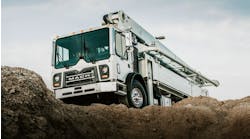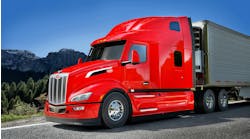When it comes funding low and zero-emissions truck fleets, California is the gold standard. The state offers one out of every three of the approximately 300 incentive programs in the U.S. and Canada that cover vehicles, infrastructure, renewable fuels, and power generation.
“We kind of treat California as its own kind of nation state in terms of incentives,” said Joe Annotti, vice president at clean energy consulting firm Gladstein, Neandross & Associates. “Generally, we look at north of $1 billion in incentives for clean transportation projects on an annual basis.”
Annotti detailed the ways fleets and carriers can overcome the speed bumps and quickly take advantage of this funding in a recent Advanced Clean Tech (ACT) News webinar called "How to Create a Competitive Funding Application."
The primary reason to go after the piles of public and private cash is to start meeting California’s strict emissions goals laid out by Assembly Bill 32 (2006) and Senate Bill 32 (2016). The legislation calls for incremental decreases in greenhouse gas (GHG) emissions. If successful, by 2050 the state’s GHG levels will be 80% of those in 1990. SB 32 called for a 40% drop by 2030.
Those lofty targets might seem too high with potential economic setbacks created by the COVID-19 pandemic, but they were instituted to inspire change.
“If California stopped all of our emissions tomorrow, it really wouldn’t change the global warming picture in a physical sense,” said Jeffery Greenblatt, staff scientist at Lawrence Berkeley National Laboratory, to The Sacramento Bee in 2016, after SB 32 was signed into law. “But we set a huge political example.”
There’s evidence this may have worked. A recent Samsara survey indicated 90% of respondents believed “EVs [electric vehicles] are the inevitable future for commercial fleets,” while 82% expect one in four of their vehicles will be an EV by 2030 at the latest.
The intersection of politics and business is a convoluted one, with funding streams coming from every which way, each with different criteria and a mess of applications to fill out. Annotti pointed out there are grants, rebates, vouchers, tax incentives, and cooperative agreements. And they might fund anything from the construction of electric vehicle charging stations or solar power generators, to battery-electric trucks, to compressed natural gas vehicles.
Instead of focusing on all the promising projects available and going after the highest dollar amount, Annotti explained the best strategy is to focus on specific fleet goals and go from there. He warned against trying to develop the product concept to fit a funding opportunity.
“You want to have what's best for you and what's best for your project in mind first, and then shop that,” he advised.
Individual fleet needs vary wildly, but each project should put the company in the best position to meet the needs of the customer, while also fulfilling state and federal regulations and providing an economic benefit. Once that is figured out, the next step is to decide what type of funding is the best fit.
Federal dollars are usually for research and development and pilot projects, while state funds focus on vehicles and infrastructure. The local level may have more funding opportunities, but with less money to offer.
Whatever a fleet decides, there are truckloads of “free” money out there, each with specific strings attached. A funding agency may seed a project with grant dollars or reimburse based on personal skin in the game. This could mean a $250,000 return on a $1 million project invoice, or the money could be dependent on engineering hours spent.
Grants are usually large-scale and done on a reimbursement basis, and rebates are done on a per-vehicle basis. If the goal is to put vehicles on the road, grants, rebate vouchers and tax incentives will be suitable, Annotti said.
In California, the Carl Moyer Program from the Bay Area Air Quality Management District has $50 million available, with a maximum of $200,000 per EV. California’s pot of the Volkswagen Settlement Program, which is part of the larger national settlement reached for the diesel-emissions scandal, is $423 million, with $90 million allocated for zero-emissions trucks. The first $30 million is set to open Q2 2020.
Keep in mind, reporting will be a big part of the funding. Proof of mileage reports and fuel or kilowatt consumption will need to be meticulously tracked.
Once the level of funding is decided, applicants must read the fine print in terms of eligibility to prevent them from wasting valuable time on the wrong funding opportunity.
“If you're trying to shoehorn a vehicle deployment project into an infrastructure funding opportunity, you've sort of misunderstood the eligibility,” Annotti said.
He said to scrutinize the type of eligible fleets and regions as well. Some might only be for public fleets or school districts, or for vehicles that run a certain amount of time within an air quality district or the state itself.
Timing also matters. If a fleet plans on using a fuel cell electric truck not due out until 2023, but the vehicle deployment must begin in 2022, obviously that wouldn’t work. As far as timing for the application review, this can take two to three months for the state agency or air district, plus another two to three months to examine and give the reward.
The final consideration is scoring. This is a competition among dozens of other qualified suitors. But trucking is all about finding a competitive edge.
“RFPs will often come with very specific scoring criteria,” Annotti said. “You get 20 points for NOx cost- effectiveness, so you get 10 points for a geographic requirement. So, writing to and appealing to those specific scoring criteria is the best approach to making sure that it's the right opportunity for you.”
It’s also prudent to do some research on previous award recipients.
“Go out and look at their winner's circle from past rounds, and you’ll get a really good sense of their style of funding,” Annotti said.
The overall message is also vitally important: Know your audience.
“If you're applying for an economic development grants, you don't necessarily want to be touting the environmental benefits of your project,” Annotti said. “You instead want to talk about cost effectiveness, and how you’ll leverage, financial third-party investment. On the flip side of that, if you're applying to an environmental agency, air quality, environment, and water quality should be front and center.”





